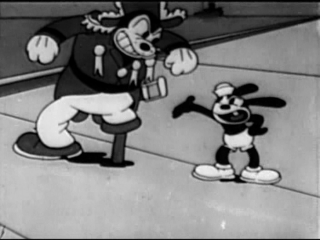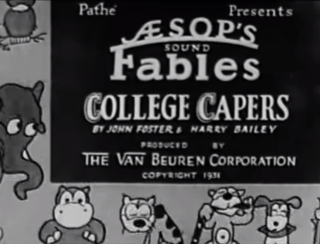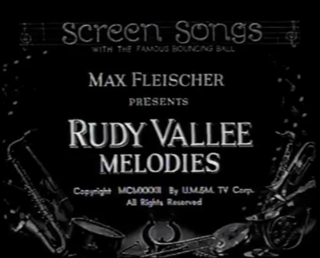
Oswald the Lucky Rabbit is an animated cartoon character created in 1928 by Walt Disney and Ub Iwerks for Universal Pictures. He starred in several animated short films released to theaters from 1927 to 1938. Twenty-seven animated Oswald shorts were produced at the Walt Disney Studio. After Universal took control of Oswald's character in 1928, Disney created a new character similar in appearance to Oswald as a replacement: Mickey Mouse, who went on to become one of the most famous cartoon characters in the world.

The Three Caballeros is a 1944 American live-action and animated musical propaganda anthology film produced by Walt Disney and released by RKO Radio Pictures. The film premiered in Mexico City on December 21, 1944. It was released in the United States on February 3, 1945 and in the United Kingdom in March 1945. It marks the tenth anniversary of Donald Duck and plots an adventure through parts of Latin America, combining live-action and animation. This is the second of the six package films released by Walt Disney Productions in the 1940s, following Saludos Amigos (1942). It is also notable for being one of the first feature-length films to incorporate traditional animation with live-action actors.

Viviane Romance was a French actress.

"Scrub Me Mama with a Boogie Beat" is a 1941 hit boogie-woogie popular song written by Don Raye. A bawdy, jazzy tune, the song describes a laundry woman from Harlem, New York, United States, whose technique is so unusual that people come from all around just to watch her scrub. The Andrews Sisters and Will Bradley & His Orchestra recorded the most successful pop versions of the song, but it is today best recognized as the centerpiece of an eponymous and controversial Walter Lantz Studio cartoon from 1941.
ThomasA.Palmer was an Italian-American animator, cartoon director, and U.S. training film supervisor. He was active in the animation industry throughout the 1920s and 1930s and was best known for his animation work at Walt Disney Productions. He spent a good chunk of his later career directing training films for the United States Army.

El Terrible Toreador is a 1929 animated cartoon produced by Walt Disney Studios in the Silly Symphonies series. The short's copyright was renewed in 1957, so it will enter the US public domain on January 1, 2025.

The Navy is a 1930 short animated film produced by Walter Lantz and as part of the Oswald the Lucky Rabbit cartoons.

The Shriek is a 1933 animated short film produced by Walter Lantz Productions as part of the Oswald the Lucky Rabbit series. The cartoon's title is a parody of the 1921 Paramount film The Sheik.

Carnival Capers is a 1932 animated short film featuring Oswald the Lucky Rabbit. It is the 65th Oswald cartoon by Walter Lantz Productions and the 117th in the entire series.
Puppet Show is a 1936 short film from Walter Lantz Productions and stars Oswald the Lucky Rabbit. Unlike most shorts made by the studio, the film employs both animation and live-action.

The Toy Shoppe is a 1934 short animated film produced by Walter Lantz Productions and is one of the many with the character Oswald the Lucky Rabbit. While the film was originally released in black and white, a colorized version was released in 1984.
Going to Blazes is a 1933 short animated film and one of many starring Oswald the Lucky Rabbit. The film is the 70th Oswald short by Walter Lantz Productions and the 122nd in the entire series.

The Cactus Kid is a Mickey Mouse short animated film first released on May 10, 1930, as part of the Mickey Mouse film series. It was the eighteenth Mickey Mouse short to be produced, the third of that year.

The Iron Man is a 1930 animated film which was directed by John Foster and Harry Bailey. It was produced by The Van Beuren Corporation, and released by Pathé, a film distributor which had the newsreel Pathé News.

College Capers is a 1931 animated short film produced by The Van Beuren Corporation and released by the film distributor Pathé.

Hot Dog is a 1930 animated short film which is presented by Max Fleischer and was also directed by Dave Fleischer. The film, which was originally released by Paramount Pictures, is the first cartoon to feature Bimbo, as he attempts to gain a lover during the film.

Rudy Vallee Melodies is a 1932 short film which is presented by Max Fleischer and was originally released by Paramount Pictures. The film, which features Betty Boop with a plethora of animals as she throws a house party in her house, stars Rudy Vallee as he sings three separate songs. The film also features sing-along versions to the songs that Vallee sings.

Hurdy Gurdy is a 1929 animated short film which is presented by Carl Laemmle and was produced by Walter Lantz, who he and his wife would go on to make Woody Woodpecker. The film, which is animated by R.C. Hamilton, Bill Nolan and Tom Palmer, features Oswald the Lucky Rabbit, who is substituted for the organ grinder's dancer, after the original one is comically swallowed up by Oswald's bubblegum.

Race Riot is a 1929 animated short film which is presented by Carl Laemmle and was produced by Walter Lantz, who would go on to produce and create the cartoon character Woody Woodpecker with his wife, Gracie Lantz. The film, which both its story and animation was composed by Walter Lantz, 'Bill' Nolan and Tom Palmer, features Oswald the Lucky Rabbit, as he attempts to win a horse race with his horse. The horse's coughs were done by Walter Lantz.

Western Whoopee is a 1930 animated short film directed by John Foster and Harry Bailey. It is part of the early cartoon series Aesop's Sound Fables. It was produced by The Van Beuren Corporation and released by the film company Pathé. It, like other Sound Fables at that time, features Milton and Rita, who resembles Mickey and Minnie Mouse greatly, so much so, Disney sued Van Beuren for the resemblance.


















